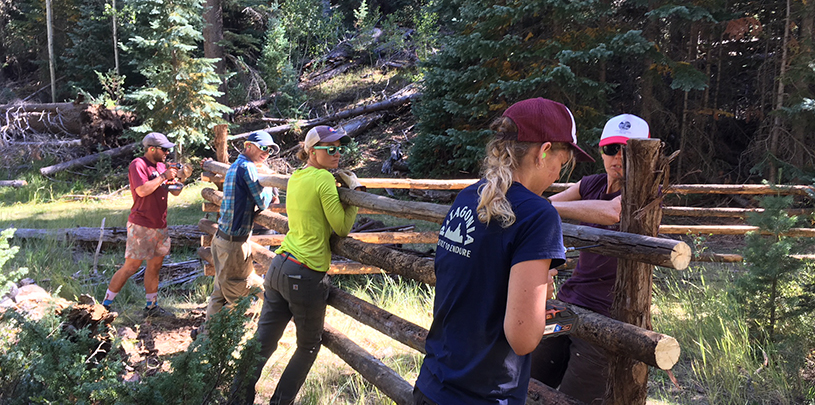
 by Lisa Winters, Research and Stewardship Volunteer Coordinator
by Lisa Winters, Research and Stewardship Volunteer Coordinator
“Click. Click. Clack.”
No, that’s not the sound of fieldwork. It’s the sound of me plunking away at my keyboard for what feels like the first time in six months. Snow dusts the peaks outside our office windows, crunchy leaves are swirling in the breeze, and I am tucked away catching up on reporting, grant writing, and planning for next season.
My field season started off in late March, navigating along stream banks on the Mogollon Rim. It was after dark, during a new moon, and very cold. The Northern Arizona University (NAU) Student Chapter of The Wildlife Society was helping the U.S. Forest Service search for Arizona toads, which vocalize loudly when they come out to breed in late evenings early in the year when snow is still melting. You may recall that Arizona didn’t have much of a winter last year. There were few toads to be found, but students gained field experience, met with Forest Service staff, and discussed water quantity issues in the desert Southwest.
The Grand Canyon Trust would be unable to take on all the work we do without the help, support, enthusiasm, and dedication of our volunteers. Ranging from 7 to 85-years-old, they are bright, passionate, and hardworking. They are aeronautical engineers, teachers, artists, students, and business executives. Most importantly, they are all advocates for a healthy, environmentally just Colorado Plateau.
 SALLY HENKEL
SALLY HENKEL
This year, with volunteer support, we repaired streambeds and collected data on grazed lands on the Mogollon Rim. We replaced barbed wire fencing with smooth wire to allow pronghorn movement throughout House Rock Valley. We revisited Johnson Lakes Canyon, where the impact of past restoration work was obvious in the flowering native plants, abundance of birds, and thriving willows. We scouted and assessed springs throughout Bears Ears and Grand Staircase-Escalante national monuments, checking the pulse on water quality and quantity in the desert Southwest. The Great Old Broads for Wilderness, a grassroots advocacy organization led by women, helped remove exotic plants from the Pando aspen stand and from an ungrazed area on the Manti-La Sal National Forest. Finally, we built fences around critical springs on the Kaibab National Forest to protect the fragile and diverse habitats from being trampled by livestock and bison.

Young people across the plateau found time to take their learning into the field. Students from NAU dove into a semester-long research project studying the impacts of uranium mining on Grand Canyon groundwater. With the help of TerraBIRDS, a nonprofit dedicated to empowering youth through gardening, Ponderosa High School students cleaned up our gardens at Kane Ranch. Biology students from Flagstaff High School continued to track Southwestern white pine growth in different climate change scenarios. Summit High School volunteers dug in, literally, to plant crops for local farmers in the Tuba City area. As previously mentioned, the NAU Student Chapter of The Wildlife Society toughed it out on a cold, dark weekend searching for tiny toads. Finally, the Prescott College Grand Canyon Semester jumped in with a beautifully crafted log fence on the North Rim.
We want to celebrate you and your commitment to helping protect the Colorado Plateau. Join us on Nov. 15, 2018, for our annual volunteer appreciation party to honor the time, dedication, and heart that volunteers donate to our work. RSVP now ›
As 2024 draws to a close, we look back at five maps we created this year that give us hope for 2025.
Read MoreThe federal government will determine if the charismatic blue bird should be listed as threatened or endangered.
Read MoreWe can’t wait to meet you in a canyon, along a creek, or in the high alpine meadows of the Colorado Plateau.
Read More